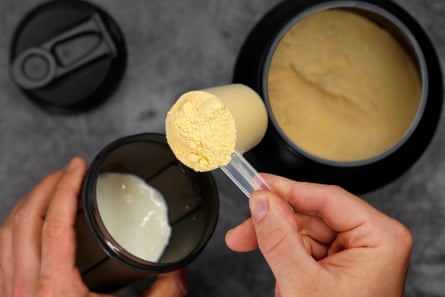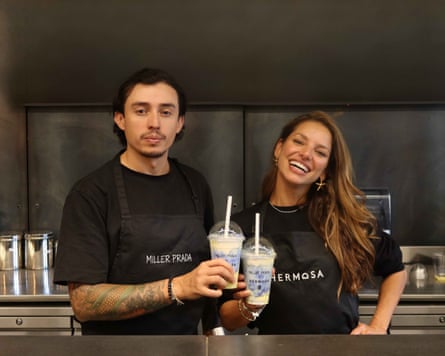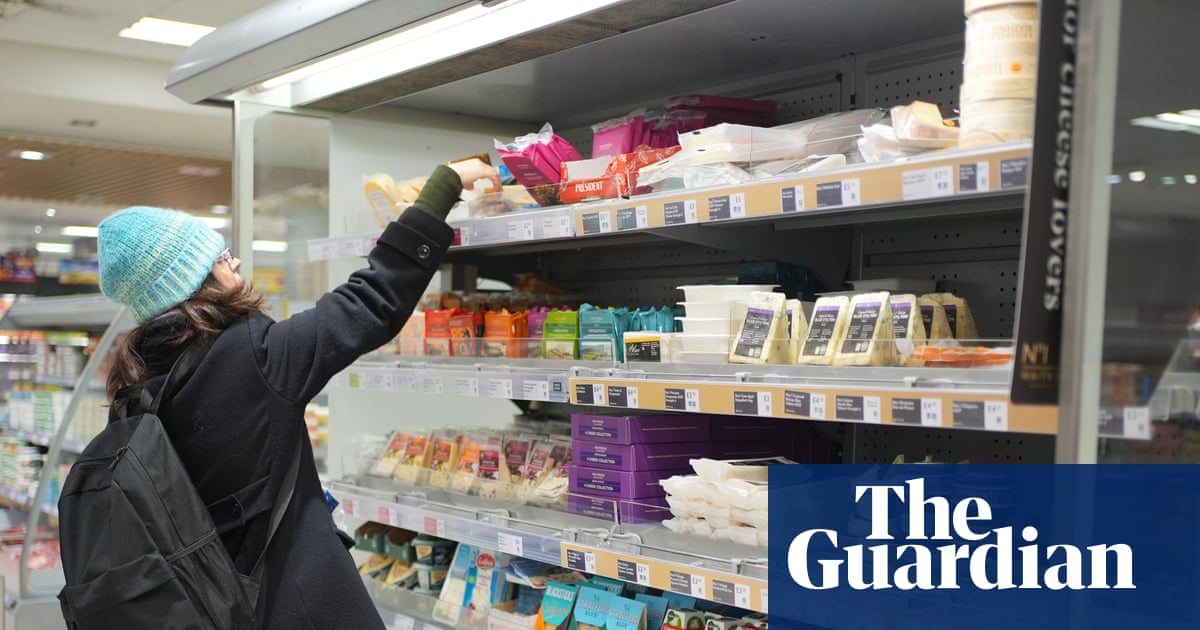I always thought my first foray into Michelin-starred culinary territory would involve sitting in a fancy restaurant feasting on some perfectly seared scallops or a magnificent rack of lamb doused in a rich jus. Instead, I’m in a fitness studio – with Doja Cat blaring through the speakers – watching my “Michelin-starred” shake come together in a blender. Inside is a scoop of vanilla protein powder, the flesh of a guanabana (a tropical fruit with a spiky exterior that tastes like a cross between a mango and a banana) and some almond milk. Saffron foam is sprayed into a plastic cup and sprinkled with some blue spirulina before the pale protein mixture is poured on top.
The resulting shake, which was developed by the Michelin-starred chef Miller Prada for Hermosa, a luxury protein powder brand sold in Barry’s, a chain of fitness studios, is like a drinkable lava lamp, with white, blue and yellow swirling softly in the cup. According to Erika Tamayo, the founder of Hermosa, it has only one comparison. “Everyone says that it looks like Vincent van Gogh’s Starry Night,” she says. Before I’m allowed to taste it, she spritzes a coffee-scented liquid on the lid and then tells me how to drink it to get the “full Michelin experience”. Place the straw about midway in the cup and suck (it should taste like an ice-cream), before shoving it down full-throttle to get a hit of the “mood-enhancing” saffron.
So, pomp aside, how does it taste? Pretty good. The texture is smooth and creamy (unlike the many gravel-textured protein shakes I’ve downed before) and the guanabana provides a subtle sweetness. Would I get it again? Maybe. The main thing holding me back is the hefty £11 price tag – though this seems to be the going rate for a fancy shake.

“We made this shake as a statement. People are now understanding that health is luxury, and everyone is investing in it,” says Tamayo. She is not the only one creating “statement” protein shakes in the UK. Elevate, which calls itself a “nutrition-focused beverage outlet” in central London, sells an £8.90 cacao shake packed with 21g of protein that promises to “support mood and bring a gentle, uplifting boost”. Similarly, Soho House members can treat themselves to a new suite of colourful, “protein-based smoothies”, priced at about £9 each, with names that wouldn’t go amiss on a cocktail menu: “The Berlin”, “The Shoreditch” and “The Beach House”.
These visually attractive, nutrient-packed health drinks really took off with the viral rise of the LA-based luxury wellness grocery stores Erewhon. While shoppers there can feast on a single strawberry imported from Japan for $20 (£15.20), or guzzle a bottle of “hyper-oxygenated” water for $26, it’s the mega-viral smoothies, which can cost more than $20 a pop, that have catapulted the brand to social media stardom. Most of them aren’t protein-based, but their striking look (perfect for an Instagram snap) and use of ingredients that can apparently give you glazed skin or even cognitive support have inspired a new flock of imitators. They have become so popular that some of the biggest stars in the world, including Sabrina Carpenter, Olivia Rodrigo and Bella Hadid, have lent their names to limited-edition Erewhon smoothies. And Erewhon has raked in huge profits as a result: $171.4m in 2023, the last year for which figures are available, despite only having 11 locations in one US state: California.
For Tamayo, taste, presentation and spectacle are key to standing out in the protein powder market, which has never been bigger (globally, it has been valued at $24.8bn, according to the market research firm Research and Markets). As well as its Michelin-starred shake, Hermosa sells “grass-fed whey protein” in an amber glass jar (containing 14 servings) for £38.
Protein is booming across the board. A YouGov survey carried out earlier this year found that 25% of UK adults regularly drink protein shakes, including 37% of 25 to 34-year-olds. The industry has grown so big, in fact, that there is now a shortage of whey, the once-discarded liquid byproduct of cheese-making that has become an ingredient used in most protein powders; it has also soared in price. So how did the world go wild for protein shakes?
Most protein powders and shakes sold today sound as if they were taken straight from a dessert menu (chocolate, Biscoff and even matcha) but, in their first iteration, they resembled more of a meaty “sludge”, says Hannah Cutting-Jones, a food historian at the University of Oregon. The first protein-based product sold to consumers dates back to 1865, when a German scientist, Justus von Liebig, invented a meat substitute, marketed as Extract of Meat, which consisted of jars of “melted-down beef hides and carcasses”. It was recommended that consumers drink a “small wine-glassful” two to three times a day. “To call it a protein shake would be very generous,” says Cutting-Jones, but it was the first product “touted as having a lot of protein”. The sludge was eventually turned into solid cubes and became a home cooking staple under a more familiar name, Oxo.

Soon after, protein products found a foothold among men seeking to buff up. From the late 1890s, Plasmon, a boxed milk protein powder plastered with images of Greek gods and muscular men, was sold across the UK and Germany. It was endorsed by the bodybuilder Eugen Sandow, who would go on to produce his own product: Health and Strength Cocoa, the world’s first chocolate protein powder. But Cutting-Jones says protein shakes really took off after the second world war, when food technology underwent a revolution. “They freeze-dried things, they turned milk into powder, and dehydrated eggs and cheeses to get them as lightweight as possible for rations boxes,” which, she says, normalised getting our nutrients from powders.
The protein industry saw its first major success in the 1950s with the introduction of Super Hi-Protein shakes, developed by the then-head coach of the US Olympic weightlifting team, Bob Hoffman. “This is probably the earliest example of a shake that would resemble anything like [what] we have today,” says Cutting-Jones (except that, instead of the nutritionally fine-tuned powders we’re used to, Hoffman would chuck Hershey’s chocolate into each batch until it tasted edible). By 1960, the product had achieved more than $1m in sales, Cutting-Jones says. The 1970s saw protein shakes making their first significant forays beyond the gym, with two popular diets, the low-carbohydrate Atkins diet and the all-liquid Last Chance diet, where those looking to lose weight fast were advised to consume nothing but protein shakes. So many Americans signed up to the latter diet, 2 million by some estimates, that the New York Times suggested that “sipping [a supplement] instead of martinis” was now customary at cocktail parties. It fell out of favour when the US government investigated whether starvation-related deaths could be attributed to it.

“People were starting to connect protein with weight loss in the 70s and 80s,” says Cutting-Jones, which was a “really key turning point for protein shakes”, though they still, for the most part, remained a bodybuilding staple. In the early 00s, this began to change. Up to that point, dieters were told that their ideal body could be achieved by avoiding fat. This longstanding assumption was shattered when studies found that people consuming a low-carbohydrate, high-protein diet lost more weight than those on a low-fat, low-cholesterol, low-calorie diet. The Atkins diet returned and protein grew in popularity. According to the Economist, global sales of sports nutrition products, most of them protein-based, doubled from 2007 to 2013, to £260m. Cutting-Jones says that from this point onwards, protein has “really been off to the races” because it could be marketed to everybody. UK-based MaxiMuscle, which went from £8.6m in sales in 2004 to £80m by 2010, broadened its appeal by releasing a product line aimed at women in 2006, and in 2012 it launched an advertising campaign for “real men”. This showed an office worker lifting a car in one hand and drinking a shake in the other. By 2011, its products were stocked in major supermarkets, including Tesco and Sainsbury’s.
Social media was the next foot on the protein pedal. The prevailing message, usually delivered by ripped (male and female) fitness influencers, was: “You’re going to be able to look like me if you buy this protein powder,” says Cutting-Jones, who calls it “a marketer’s dream come true”. MyProtein, which was set up in 2004 with a £500 overdraft before soaring to its current valuation of at least £400m, became the influencers’ brand of choice in the 2010s, but love for the products was probably not the only reason for plugging its shakes. The firm has had a long-running brand ambassador campaign where, as of 2025, influencers with more than 10,000 followers can earn up to 8% commission on each MyProtein product sold.
But how much protein do we really need? The UK government says that men aged 19-50 should be eating about 55g of protein a day, roughly equivalent to nine eggs, and women in the same age bracket should consume about 45g, about the same as seven eggs. According to Dr Linia Patel, a nutritionist at Pure Sports Medicine, these recommendations are “more about preventing malnutrition” and, as a starting point, to thrive people should be “eating about 1g per kilogram of body weight, or 1.2g if they’re active”.
Patel says protein helps us feel fuller for longer because it’s a “complex molecule”. This means that when we eat it, it takes “a little bit more work for our bodies to metabolise and digest it”, but there is such a thing as too much protein. Patel says going above 2g to 2.2g per kg of body weight consistently – as anyone on the all-animal-product carnivore diet might, for instance – is probably too much protein, because it risks “displacing other key nutrients”, including fibre.

When it comes to finding the best way of consuming protein, she says, “Food first should be our priority” because whole food sources such as meats, fish and eggs are packed with nutrients, minerals and compounds “that supplements can’t replicate”. However, protein powders can have their place. “We need to use them as a tool, v being your go-to,” she says. She recommends going for an unflavoured powder as a regular option because “there’s lots of sweeteners and emulsifiers” in heavily flavoured options. And if you’re making a shake to replace a meal, adding ingredients such as Greek yoghurt, fruit or nut butters can help make it more “balanced”.
It’s not just shakes and powders that have benefited from the protein craze. A 2023 study found about 1,200 products making protein claims on UK supermarket shelves, including cereals, cheese and even pancakes. Dr Ada Garcia, a public health nutritionist at the University of Glasgow, who led the study, says most of these foods met a nutritional threshold to be “classified as healthy”, but she cautions shoppers to pay attention to how these protein claims are phrased.
Under EU laws, which are still in place in the UK, for a product to be labelled a “source of protein”, the nutrient must make up at least 12% of its energy value. If something is labelled “high protein”, 20% of the product’s energy value must be provided by protein. Other phrases are more of a minefield. “There are things that manufacturers can say, for example: that a food provides a protein kick or a protein boost or is rich in protein. These claims are not regulated so they can add whatever amount of protein they like,” says Garcia.
Protein mania shows no signs of slowing down, but at what point does it tip into an unhealthy obsession? Last year, the Grocer published a survey that found 77% of people in the UK are looking to eat more protein, more than any other nutrient, including fibre (60%), probiotics (48%) and, unsurprisingly, fat (9%). “People are really nervous that they’re not getting enough protein, and I think a lot of social media influencers are really banking on that,” says Cutting-Jones.
TikTok is full of videos of young people dry-scooping – where protein powders are eaten raw, without any liquid. Cutting-Jones says this dangerous trend (health experts have warned that it can cause choking or infection) shows how things have “spiralled” out of control when it comes to tracking our nutrients. “We shouldn’t replace all the other facets of what food is by counting our every calorie and macronutrient intake. We’re not robots – food is about being human,” she says.

 3 hours ago
10
3 hours ago
10

















































